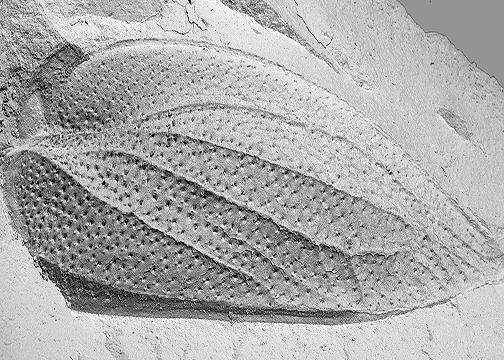Abstract
Scytinopteridae Handlirsch, 1906 is a widespread family of extinct Cicadomorpha known worldwide from the Permian and Triassic (Lambkin, 2016). This family was understood very broadly (e.g., Evans, 1956), but was later restricted to the genera with heavily sclerotized punctate tegmina having a costal fracture and a hypocostal socket fixed on the thorax in repose, and was placed in the superfamily Scytinopteroidea Handlirsch, 1906 (Shcherbakov, 1984). Based on these features, scytinopteroids are considered inhabitants of waterside vegetation capable of temporary submergence, and are ancestors of true bugs (Shcherbakov, 1996, 2000). In the beds near the Permian-Triassic boundary of Mongolia, an unusual new genus of Scytinopteridae was discovered with pointed coleopterous tegmina lacking the costal fracture and the claval furrow. These modifications indicate that the flying ability in the new scytinopterid was reduced or lost, and the peculiar shape of the tegmina probably helped to mimic host plant buds or seeds (plant-part mimicry).
References
Aristov, D.S. (2005) New grylloblattids (Insecta: Grylloblattida) from the Triassic of eastern Europe, eastern Kazakhstan and Mongolia. Paleontological Journal, 39, 173–177.
Aristov, D.S. (2011) New and little known Grylloblattida (Insecta) from intertrappean deposits of the Tunguska Basin of Sibiria. Paleontological Journal, 45, 537–545. https://doi.org/10.1134/S0031030111050030
Durante, M.V. & Luvsantseden, U. (2002) Developmental features of the southern branch of the Subangaran paleofloristic region. In: Akhmetiev, M.A., Doludenko, M.P., Herman, A.B. & Ignatiev, I.A. (Eds), Special volume, dedicated to the memory of the Corresponding member of the USSR Academy of Sciences, Professor Vsevolod Andreevich Vakhrameev (to the 90th anniversary of his birth). GEOS, Moscow, pp. 247–261. [In Russian]
Evans, J.W. (1946) A natural classification of leaf-hoppers. Part 1. Transactions of the Entomological Society of London, 96, 47–60. https://doi.org/10.1111/j.1365-2311.1946.tb00442.x
Evans, J.W. (1956) Palaeozoic and Mesozoic Hemiptera (Insecta). Australian journal of Zoology, 4, 165–258. https://doi.org/10.1071/ZO9560165
Gomankov, A.V. (2020) Peculiar lycopsids from Yaman-Us locality (the Upper Permian of the Southern Mongolia). Lethaea rossica, 20, 34–43. [In Russian]
Handlirsch, A. (1906–1908) Die fossilen Insekten und die Phylogenie der rezenten Formen. Verlag von Wilhelm Engelmann, Leipzig, ix + 1430 pp + 51 plates. https://doi.org/10.5962/bhl.title.34145
Ignatov, M.S. & Shcherbakov, D.E. (2011) Lower Triassic mosses from Yaman Us (Mongolia). Arctoa, 20, 65–80. https://doi.org/10.15298/arctoa.20.04
Lambkin, K.J. (2016) Revision of the Scytinopteridae (Hemiptera: Cicadomorpha: Scytinopteroidea) of the Queensland Triassic. Zootaxa, 4117 (4), 580–590. https://doi.org/10.11646/zootaxa.4117.4.9
Linnaeus, C. (1758) Systema naturae per regna tria naturae, secundum classes, ordines, genera, species, cum characteribus, differentiis, synonymis, locis. Tomus I. Editio decima, reformata. Laurentii Salvii, Holmiae, [4] + 824 pp. https://doi.org/10.5962/bhl.title.542
Shcherbakov, D.E. (1984) Systematics and phylogeny of Permian Cicadomorpha (Cimicida and Cicadina). Paleontological Journal, 1984 (2), 87–97.
Shcherbakov, D.E. (1996) Origin and evolution of the Auchenorrhyncha as shown by the fossil record. In: Schaefer, C.W. (Ed.), Studies on Hemipteran Phylogeny. Entomological Society of America, Lanham, Maryland, pp. 31–45.
Shcherbakov, D.E. (2000) Permian faunas of Homoptera (Hemiptera) in relation to phytogeography and the Permo-Triassic crisis. Paleontological Journal, 34 (Suppl. 3), S251–S267.
Shcherbakov, D.E. (2008) Insect recovery after the Permian/Triassic crisis. Alavesia, 2, 125–131.
Shcherbakov, D.E., Vinn, O. & Zhuravlev, A.Y. (2021) Disaster microconchids from the uppermost Permian and Lower Triassic lacustrine strata of the Cis-Urals and the Tunguska and Kuznetsk basins (Russia). Geological Magazine, 158, 1335–1357. https://doi.org/10.1017/S0016756820001375
Sinitshenkova, N.D. (2013) New mayflies (Insecta: Ephemerida = Ephemeroptera) from the intertrappean deposits of the Tunguska Basin, Siberia. Paleontological Journal, 47, 84–88. https://doi.org/10.1134/S0031030113010127
Sinitshenkova, N.D. (2021) A new mayfly species Triassodotes rasnitsyni sp. nov. of the family Misthodotidae Tillyard, 1932 (Insecta; Ephemerida, Permoplectoptera) from the Triassic deposits of Kuzbass, Russia. Palaeoentomology, 4 (5), 429–432. https://doi.org/10.11646/palaeoentomology.4.5.6
Tillyard, R.J. (1919) Mesozoic insects of Queensland. No. 7. Hemiptera Homoptera; with a note on the phylogeny of the suborder. Proceedings of the Linnean Society of New South Wales, 44, 857–896.
Uranbileg, L. (2020) Phytostratigraphy and flora of the Middle-Upper Permian coal-bearing deposits of the South Mongolia. Transactions of the Joint Russian-Mongolian Paleontological Expedition, 49, 1–144. [In Russian]


